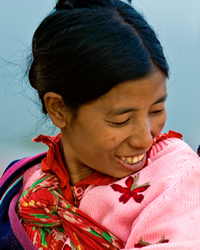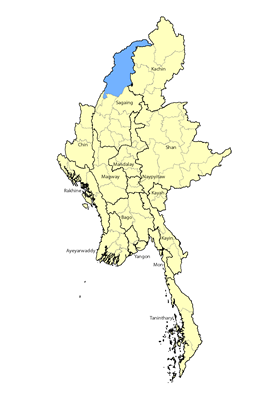The autonym, language name, and village name of this tribe is Gaqha, but other groups call them Haqlum. They are one of 49 different similar tribes profiled in this book, all of which have their own identities and dialects. Most of them, including the Gaqha, have never appeared in any lists of Myanmar's people groups until now. Historically they were considered part of the Naga ethnicity, but they broke away from the Nagas and insisted on their own identity. In Myanmar today there are still 16 tribes that are proud to call themselves Naga. They have all been profiled in Operation Myanmar.
Location: With a modest population of approximately 500, the Gaqha people live in Gaqha Village in Dunghi town, which is part of the larger Nanyun Township in northwest Myanmar's Sagaing Region. Nanyun borders the state of Nagaland in northeast India. One source described a typical village in this area: “They traditionally build their villages on the summit of a hill or spur running off a mountain range, 3,000 to 4,000 feet above sea level. This type of location was sought primarily for defense purposes, and villages often had a protective stone wall, dike, or fence.”
Language: In 2012, a team of linguists visited the area and surveyed 180 Gaqha people in 35 households. They ascertained that the Gaqha language is part of a group of four related varieties, the others being Drancyi, Gaqlun and Raraq. Many other dialects are completely unintelligible to the Gaqha, however, which indicates the quartet of groups likely came from a common tribe centuries ago before they became isolated from each other and developed separately.
Strangely, although they were feared as fierce headhunters in the past, they are also known for their warm hospitality. During the Second World War, Japanese bombers flattened the city of Mandalay and missionaries were in danger of being killed, when a plan was devised for them to flee the country on elephants to the safety of India. To do so required traveling through the remote mountains. The Associated Press reported: “Mounted on elephants, American Baptist missionaries bumped along goat tracks in the ancient jalopies in which they once toured their parishes, and fierce tribesmen found rescue work more profitable and exciting than headhunting. The American missionaries… shepherded a swarm of refugee men, women and children along the track.”
The Gaqha people lead simple lives and rarely venture outside their immediate area. The men are expert hunters, obtaining an abundance of meat from the dense forests in the area, while women are skilled weavers. The Gaqha are bound by an honor code to protect and help all visitors who enter their homes. Even though many of them are impoverished, they do not hesitate to bless their guests in ways they would not normally do for themselves.
Although all residents of Gaqha village are Christians today, for centuries they lived in fear of demons that needed to be regularly placated to avoid disease or other disasters. Although initial efforts to reach them were undertaken by Kachin Jingpo Christians in 1906, few converted until the 1950s and 1960s. What began as a small trickle of believers grew into a powerful revival, which saw entire tribes embrace the Gospel and be transformed.
All Gaqha Christians are members of the Baptist denomination. Although the area is currently wracked with violence, with armed insurgency groups active on both sides of the Myanmar-India border, many believers are joyful people who love to come together to sing. The absence of any Scriptures in a language they can easily understand has created barriers to their spiritual maturity in Christ.
Scripture Prayers for the Gaqha in Myanmar (Burma).
| Profile Source: Asia Harvest Copyrighted © Used with permission |











